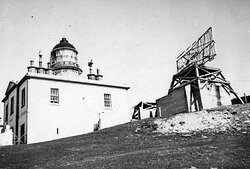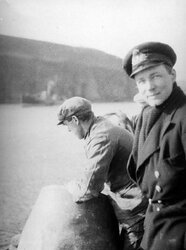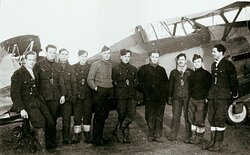World War II
 Radar array at Sumburgh Head (image by Charles Feacham)
Sumburgh Head posesses a fascinating wartime military history that had a potentially significant influence on the outcome of World War II.
Radar array at Sumburgh Head (image by Charles Feacham)
Sumburgh Head posesses a fascinating wartime military history that had a potentially significant influence on the outcome of World War II.
During the twentieth century, Shetland played a crucially important role in the defence of Britain during both World Wars due to its strategic military location on the northern periphery of Britain and Europe. The Straits of Dover represented a vulnerable and dangerous naval passage, and so enemy shipping and submarines used the North Sea as their favoured passage to the North Atlantic Ocean. Shetland was therefore an important base for the Royal Navy and the Royal Air Force, who patrolled the surrounding waters, and for the associated military radar stations, scanning the skies and seas. One such radar station was established within the grounds of Sumburgh Head Lighthouse in autumn 1939.
It had been argued that erecting a military installation within the grounds of a lighthouse was to break the Geneva Convention. The rules of war stated that lighthouses were not legitimate military targets. Both the Northern Lighthouse Board and the Ministry of Shipping had strong objections to using lighthouse premises for such belligerent purposes. However, an Admiralty letter of 17th December 1939 states that 'The Admiralty view... is still what it was in the late war and the intervening years, i.e. that they shoudl not be used overtly for belligerent purposes'
 Sub-Lieutenant Richard Feachem (image supplied by Charles Feacham)
Although manned by the Navy and protected by an army guard, the commanding officers at Sumburgh Head were not typically military men. There were 18 staff including the officer-in-charge, a cook, four telegraphists, two technicians, a steward, eight radar operators and a stoker. Sub-Lieutenant Richard Feachem had been an archeaologist, and Sub-Lieutenant George Clifford Evans, a plant physiologist.
Sub-Lieutenant Richard Feachem (image supplied by Charles Feacham)
Although manned by the Navy and protected by an army guard, the commanding officers at Sumburgh Head were not typically military men. There were 18 staff including the officer-in-charge, a cook, four telegraphists, two technicians, a steward, eight radar operators and a stoker. Sub-Lieutenant Richard Feachem had been an archeaologist, and Sub-Lieutenant George Clifford Evans, a plant physiologist.
Perhaps the most famous tale associated with Sumburgh Head Admiralty Experimental Station 1 is its role in thwarting a surprise German air raid at Scapa Flow on the evening of 8th April 1940. On this night, around 60 Luftwaffe bombers took off from Germany, intent on the destruction of the British Home Fleet, at anchor in Scapa Flow in Orkney. The fleet had only just returned to Orkney in March, following the construction of the 'Churchill Barriers' designed to prevent U-Boat attacks. On the eve of the German invasion of Norway and Denmark, the bombers crossed the North Sea in an attempt to neutralise the British Home Fleet.
Sub-Lieutenant George Clifford Evans was on duty that evening. Having detected the raid, approximately 100 miles south-east of Sumburgh, he was able to provide a 25 minute warning of the threat to the commanding officer at Lyness on the western flank of Scapa Flow. As the aircraft continued to be tracked, Evans stepped outside on what was a clear starlit night, and witnessed a 'tremendous firework display' as the Scapa barrage repelled the enemy attack.
 The noise of anti-aircraft fire was heard in Lerwick - 125 miles from Scapa Flow - and was referred to at the time as 'the loudest continuous sound ever heard in the British Isles.' Had this raid been sucessful, British Naval power would have been compromised, potentially indluencing the course of the whole war. The radar station at Sumburgh Head played a fundamental role in providing the early warning to avert what was described by one of the wartime radar operators as 'the Pearl Harbour that might have been.' George Clifford Evans later wrote 'when we heard that no serious damage had been done, I told my crew that if the stations never made any other contribution to the war we had already justified the entire enterprise.'
The noise of anti-aircraft fire was heard in Lerwick - 125 miles from Scapa Flow - and was referred to at the time as 'the loudest continuous sound ever heard in the British Isles.' Had this raid been sucessful, British Naval power would have been compromised, potentially indluencing the course of the whole war. The radar station at Sumburgh Head played a fundamental role in providing the early warning to avert what was described by one of the wartime radar operators as 'the Pearl Harbour that might have been.' George Clifford Evans later wrote 'when we heard that no serious damage had been done, I told my crew that if the stations never made any other contribution to the war we had already justified the entire enterprise.'

